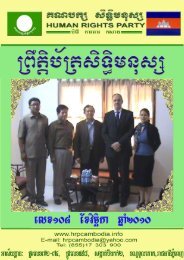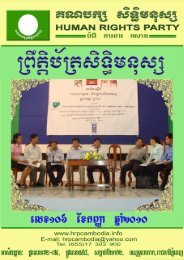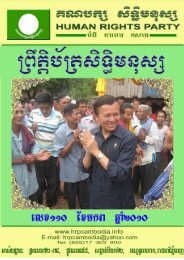Losing Ground - Human Rights Party.
Losing Ground - Human Rights Party.
Losing Ground - Human Rights Party.
Create successful ePaper yourself
Turn your PDF publications into a flip-book with our unique Google optimized e-Paper software.
<strong>Losing</strong> <strong>Ground</strong><br />
Indigenous Community Lands<br />
As discussed above, there is a classification of land called<br />
Collective Indigenous Community Property, which gives<br />
ownership of traditional indigenous lands to the entire<br />
community. This right does not bestow individual ownership<br />
rights on members of the community, but permits the land<br />
to be owned and managed according to traditional custom.<br />
Currently, no indigenous land in Cambodia is registered as the<br />
relevant implementing laws are still pending.<br />
Legal framework<br />
The Sub-decree on Procedures for Registration of Indigenous<br />
Community Land was passed in May 2009, however, before<br />
land can be registered, the community must first be registered<br />
as a legal entity with the Ministry of Interior. 45 The procedure<br />
for registering the community will be set out in a sub-decree<br />
drafted by the ministry, however, there is no public draft of<br />
this sub-decree, and no clear information on when it will be<br />
completed and passed. In addition to this, draft documents<br />
for the Land Administration Sub-Sector Program 46 state that a<br />
further prakas on registering indigenous land will be drafted.<br />
Interim protection<br />
Although it is still not possible to legally register indigenous<br />
land, and in all likelihood may not be possible for some time,<br />
Article 23 of the 2001 Land Law provides strong and immediate<br />
interim protection of indigenous communities’ rights: “Prior to<br />
their legal status being determined under a law on communities,<br />
the groups actually existing at present shall continue to manage<br />
their community and immovable property according to their<br />
traditional customs and shall be subject to the provisions of this<br />
law.” The indigenous community therefore shall be subject to<br />
legal protection even though they are yet to be registered.<br />
According to Article 23 of the Land Law 2001: “An<br />
indigenous community is a group of people that resides in<br />
the territory of the Kingdom of Cambodia whose members<br />
manifest ethnic, social, cultural and economic unity and who<br />
practice a traditional lifestyle, and who cultivate the lands in<br />
their possession according to customary rules of collective use.”<br />
However, local authorities and private companies sometimes<br />
avoid the strong protections of the land law by claiming that<br />
certain communities are not an indigenous community because<br />
they no longer wear traditional clothing (banned during the<br />
Khmer Rouge reign) and because they now use mobile phones<br />
and motorbikes. This however is not a valid claim if the<br />
community still practices a collective way of life, for example,<br />
collective decision making.<br />
Article 25 of the Land Law states, “The lands of indigenous<br />
communities are those lands where the said communities have<br />
established their residences and where they carry out traditional<br />
agriculture.” Paragraph 2 of the same Article emphasizes that,<br />
“The lands of indigenous communities include not only lands<br />
actually cultivated but also includes reserved lands necessary for<br />
the shifting of cultivation which is required by the agricultural<br />
methods they currently practice and which are recognized by<br />
the administrative authorities.”<br />
The indigenous community lands however are not only for<br />
residences and traditional agriculture. During a debate on<br />
Chapter 3 of the Land Law at the National Assembly, Bou Thong,<br />
member of the National Assembly from Ratanakkiri explained<br />
that, “The management styles [of indigenous people], there<br />
are three to four styles: management of lands for residence,<br />
management of lands for subsistence such as farmlands,<br />
management of lands as a reserve lands or abandoned lands,<br />
and fourth, management of lands as spirit forest and land, a<br />
place for worship the one’s whole life. No one or organization<br />
can violate the indigenous tradition.” Spirit forest land and<br />
burial forest land are included in the definition of indigenous<br />
community land entitled to be registered as collective land. 47<br />
Further to this, various statements have been made by<br />
government officials and institutions, for example, the Council<br />
on Land Policy and provincial authorities in Mondulkiri and<br />
Ratanakkiri, that the transfer of indigenous property to people<br />
outside the community is illegal.<br />
Local authorities and private companies<br />
sometimes avoid the strong protections<br />
of the Land Law by claiming that certain<br />
communities are not an indigenous<br />
community because they no longer wear<br />
traditional clothing (banned during the<br />
Khmer Rouge reign) and because they now<br />
use mobile phones and motorbikes.<br />
45<br />
Article 3, Sub-decree on Procedures of Registration of Land of Indigenous Communities.<br />
46<br />
One of the three Ministry of Land sub-sector programs that make up the Land Administration, Management and Distribution Program. The other two are the Land<br />
Management Sub-Sector Program and Land Distribution Sub-Sector Program.<br />
47<br />
Sub-decree on Procedures of Registration of Land of Indigenous Communities, Article 6.<br />
70<br />
Forced Evictions and Intimidation in Cambodia






